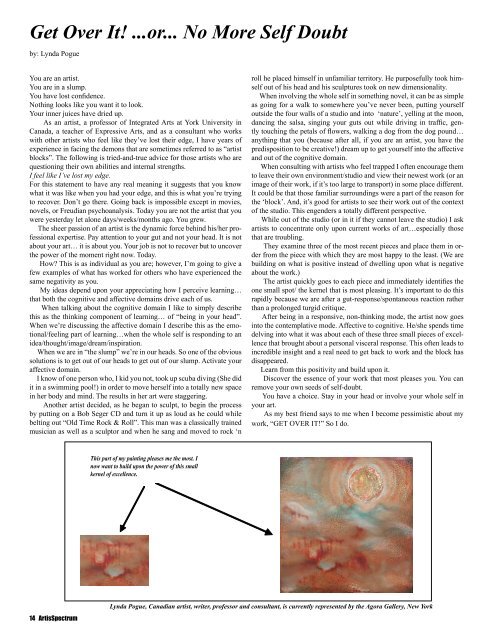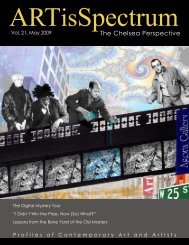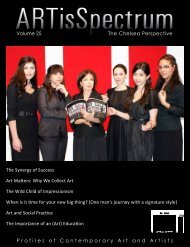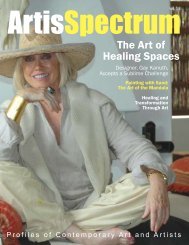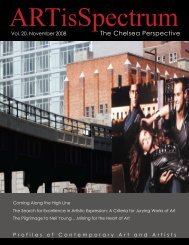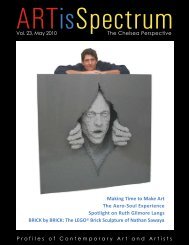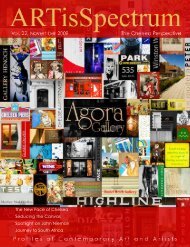CHELSEA ART: The New Thirty-Something Block ... - ARTisSpectrum
CHELSEA ART: The New Thirty-Something Block ... - ARTisSpectrum
CHELSEA ART: The New Thirty-Something Block ... - ARTisSpectrum
- No tags were found...
Create successful ePaper yourself
Turn your PDF publications into a flip-book with our unique Google optimized e-Paper software.
Get Over It! ...or... No More Self Doubtby: Lynda PogueYou are an artist.You are in a slump.You have lost confidence.Nothing looks like you want it to look.Your inner juices have dried up.As an artist, a professor of Integrated Arts at York University inCanada, a teacher of Expressive Arts, and as a consultant who workswith other artists who feel like they’ve lost their edge, I have years ofexperience in facing the demons that are sometimes referred to as “artistblocks”. <strong>The</strong> following is tried-and-true advice for those artists who arequestioning their own abilities and internal strengths.I feel like I’ve lost my edge.For this statement to have any real meaning it suggests that you knowwhat it was like when you had your edge, and this is what you’re tryingto recover. Don’t go there. Going back is impossible except in movies,novels, or Freudian psychoanalysis. Today you are not the artist that youwere yesterday let alone days/weeks/months ago. You grew.<strong>The</strong> sheer passion of an artist is the dynamic force behind his/her professionalexpertise. Pay attention to your gut and not your head. It is notabout your art… it is about you. Your job is not to recover but to uncoverthe power of the moment right now. Today.How? This is as individual as you are; however, I’m going to give afew examples of what has worked for others who have experienced thesame negativity as you.My ideas depend upon your appreciating how I perceive learning…that both the cognitive and affective domains drive each of us.When talking about the cognitive domain I like to simply describethis as the thinking component of learning… of “being in your head”.When we’re discussing the affective domain I describe this as the emotional/feelingpart of learning…when the whole self is responding to anidea/thought/image/dream/inspiration.When we are in “the slump” we’re in our heads. So one of the obvioussolutions is to get out of our heads to get out of our slump. Activate youraffective domain.I know of one person who, I kid you not, took up scuba diving (She didit in a swimming pool!) in order to move herself into a totally new spacein her body and mind. <strong>The</strong> results in her art were staggering.Another artist decided, as he began to sculpt, to begin the processby putting on a Bob Seger CD and turn it up as loud as he could whilebelting out “Old Time Rock & Roll”. This man was a classically trainedmusician as well as a sculptor and when he sang and moved to rock ‘nroll he placed himself in unfamiliar territory. He purposefully took himselfout of his head and his sculptures took on new dimensionality.When involving the whole self in something novel, it can be as simpleas going for a walk to somewhere you’ve never been, putting yourselfoutside the four walls of a studio and into ‘nature’, yelling at the moon,dancing the salsa, singing your guts out while driving in traffic, gentlytouching the petals of flowers, walking a dog from the dog pound…anything that you (because after all, if you are an artist, you have thepredisposition to be creative!) dream up to get yourself into the affectiveand out of the cognitive domain.When consulting with artists who feel trapped I often encourage themto leave their own environment/studio and view their newest work (or animage of their work, if it’s too large to transport) in some place different.It could be that those familiar surroundings were a part of the reason forthe ‘block’. And, it’s good for artists to see their work out of the contextof the studio. This engenders a totally different perspective.While out of the studio (or in it if they cannot leave the studio) I askartists to concentrate only upon current works of art…especially thosethat are troubling.<strong>The</strong>y examine three of the most recent pieces and place them in orderfrom the piece with which they are most happy to the least. (We arebuilding on what is positive instead of dwelling upon what is negativeabout the work.)<strong>The</strong> artist quickly goes to each piece and immediately identifies theone small spot/ the kernel that is most pleasing. It’s important to do thisrapidly because we are after a gut-response/spontaneous reaction ratherthan a prolonged turgid critique.After being in a responsive, non-thinking mode, the artist now goesinto the contemplative mode. Affective to cognitive. He/she spends timedelving into what it was about each of these three small pieces of excellencethat brought about a personal visceral response. This often leads toincredible insight and a real need to get back to work and the block hasdisappeared.Learn from this positivity and build upon it.Discover the essence of your work that most pleases you. You canremove your own seeds of self-doubt.You have a choice. Stay in your head or involve your whole self inyour art.As my best friend says to me when I become pessimistic about mywork, “GET OVER IT!” So I do.This part of my painting pleases me the most. Inow want to build upon the power of this smallkernel of excellence.Lynda Pogue, Canadian artist, writer, professor and consultant, is currently represented by the Agora Gallery, <strong>New</strong> York14 ArtisSpectrum


